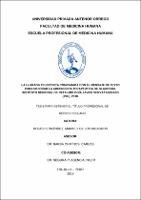Mostrar el registro sencillo del ítem
La llamada telefónica comparada con el mensaje de texto para mejorar la adherencia terapéutica de glaucoma. Instituto Regional de Oftalmología Javier Servat Ubinazo (JSU), 2018
| dc.contributor.advisor | Barba Chirinos, Carlos | |
| dc.contributor.author | Rojas Fernández, Mariely de los Milagros | |
| dc.creator | Rojas Fernández, Mariely de los Milagros | |
| dc.date.accessioned | 2019-03-21T11:56:29Z | |
| dc.date.available | 2019-03-21T11:56:29Z | |
| dc.date.issued | 2019 | |
| dc.identifier.uri | https://hdl.handle.net/20.500.12759/4566 | |
| dc.description.abstract | Objetivo: Determinar si la llamada telefónica comparada con el mensaje de texto mejora la adherencia terapéutica de Glaucoma. Instituto Regional de OftalmologíaJavier Servat Unibazo (JSU), 2018. Material y métodos: Estudio cuasiexperimental. El tamaño muestral fue de 88 pacientes no adherentes con diagnóstico de glaucoma que se encuentra recibiendo tratamiento en el Instituto Regional de Oftalmología Javier Servat Unibazo (JSU), durante el año 2018. La comparación de variables se realizó mediante la comparación de proporciones, grupos independientes. Resultados: El género, la edad, nivel académico, número de gotas diarias, medicamento que utiliza para el glaucoma, persona que se encarga de administrar el colirio, tiempo que usa el colirio y la toma de otros medicamentos no mostraron una asociación estadísticamente significativa con ser adherente o no (p > 0,05). Referente a la llamada telefónica comparada con el mensaje de texto en la mejora de adherencia terapéutica de Glaucoma no existen diferencias estadísticas para afirmar que el porcentaje de adherencia terapéutica de glaucoma es mejor en pacientes que recibieron el aviso por llamada telefónica en comparación a los que recibieron por mensaje de texto (p > 0,05) Conclusión: La Llamada telefónica comparada con el mensaje de texto mejora la adherencia terapéutica de Glaucoma. | es_PE |
| dc.description.abstract | Objective: To determine if the telephone call compared with the text message improves the therapeutic adherence of Glaucoma. Regional Institute of Ophthalmology Javier Servat Unibazo (JSU), 2018. Material and methods: Quasi-experimental study. The sample size was 88 non-adherent patients with a diagnosis of glaucoma who is receiving treatment at the Regional Institute of Ophthalmology Javier Servat Unibazo (JSU), during 2018. The comparison of variables was made by comparing proportions, independent groups. Results: Gender, age, academic level, number of drops daily, medication used for glaucoma, person who is responsible for administering eye drops, time using eye drops and taking other medications did not show a statistically significant association with being adherent or not (p > 0,05). Regarding the telephone call compared with the text message in the improvement of Glaucoma therapeutic adherence, there are no statistical differences to affirm that the percentage of glaucoma therapeutic adherence is better in patients who received the notice by telephone call in comparison to those who received by text message (p> 0.05). Conclusion: Telephone call compared with the text message improves the therapeutic adherence of Glaucoma. | en_US |
| dc.description.uri | Tesis | es_PE |
| dc.format | application/pdf | es_PE |
| dc.language.iso | spa | es_PE |
| dc.publisher | Universidad Privada Antenor Orrego - UPAO | es_PE |
| dc.relation.ispartofseries | T_MED.HUMA_2544 | |
| dc.rights | info:eu-repo/semantics/openAccess | es_PE |
| dc.source | Universidad Privada Antenor Orrego | es_PE |
| dc.source | Repositorio Institucional - UPAO | es_PE |
| dc.subject | Llamada telefónica | es_PE |
| dc.subject | Mensaje de texto | es_PE |
| dc.subject | Adherencia terapéutica | es_PE |
| dc.title | La llamada telefónica comparada con el mensaje de texto para mejorar la adherencia terapéutica de glaucoma. Instituto Regional de Oftalmología Javier Servat Ubinazo (JSU), 2018 | es_PE |
| dc.type | info:eu-repo/semantics/bachelorThesis | es_PE |
| thesis.degree.level | Título Profesional | es_PE |
| thesis.degree.grantor | Universidad Privada Antenor Orrego. Facultad de Medicina Humana | es_PE |
| thesis.degree.name | Médico Cirujano | es_PE |
| thesis.degree.discipline | Medicina Humana | es_PE |
Ficheros en el ítem
Este ítem aparece en la(s) siguiente(s) colección(es)
-
Medicina Humana [2739]

